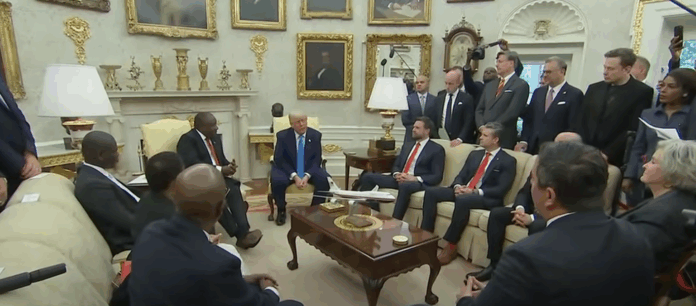Donald Trump’s racism and derangement were on full display during his Oval Office meeting on Wednesday with South African President Cyril Ramaphosa.
And while news headlines fell well short of proclaiming the lunacy and hatefulness of his remarks, reporters at our top media outlets at least came closer than they have before to openly addressing Trump’s vehemently racist views.
Consider the New York Times’s main story, “Trump Lectures South African President in Televised Oval Office Confrontation.” The headline utterly failed to alert readers to Trump’s extraordinary bigotry.
But the article itself, at least by the time the fourth paragraph rolled around, gave readers an indication:
The meeting quickly became a stark demonstration of Mr. Trump’s belief that the world has aligned against white people, and that Black people and minorities have received preferential treatment. In the case of South Africa, that belief has ballooned into claims of genocide.
And this keen observation was certainly telling:
Mr. Trump scowled and dismissed Mr. Ramaphosa and his delegates during the meeting, including a Black woman who tried to explain that brutal crimes happen to Black people in the country as well.
By contrast, Mr. Trump joked around and listened attentively as [white South African golfers Ernie Els and Retief Goosen] and Johann Rupert, a white South African billionaire, said crime was prevalent across the board in the nation, not just against white farmers.
An accompanying news analysis by Zolan Kanno-Youngs went even further. Despite its restrained Timesian language, it packed quite a wallop:
The confrontation provided a vivid demonstration of Mr. Trump’s views on race, which have animated his political life going back years. After rising to power in part by framing himself as a protector of white America, Mr. Trump has used his platform, in this case the Oval Office, to elevate claims of white grievance.
For Mr. Trump, white people are the true victims; Black people and minorities have received an unfair advantage in the United States. And when Mr. Trump looks to South Africa, a majority-Black country emerging from a legacy of apartheid and colonialism, he sees white people who need sanctuary in the United States.
And the article included some appropriately blunt words from a knowledgeable source:
Derrick Johnson, the president of the N.A.A.C.P., said Mr. Trump’s remarks in the Oval Office were “extremely biased and racist.”
“It was a sickening display of propaganda that’s dangerous and consistent of his narrative, whether it’s domestically or globally,” Mr. Johnson said.
Mr. Johnson said Mr. Trump had a worldview “where he can only see him and people that resemble him.”
The Washington Post’s coverage was less impressive. Its headline was wildly inadequate: “Trump confronts South African president, pushing claims of genocide”. And consider this bizarre whitewash of a lead:
President Donald Trump pressed South African President Cyril Ramaphosa to protect White Afrikaner farmers from violent attacks in an extraordinary Oval Office confrontation Wednesday in which it fell to others to remind Trump of the nation’s long-standing epidemic of violence against both White and Black people.
But the second paragraph at least made it clear that Trump was lying:
Trump amplified false claims that White Afrikaners have been victims of a genocide, even showing video of crosses and earthen mounds that he said represented more than 1,000 grave sites of murdered farmers. The mounds were in fact part of a protest against the violence, not actual graves.
And despite the mealy-mouthed language, the meaning of this paragraph was hard to misconstrue:
The remarkable exchange… showcased Trump’s selective, and racially polarizing, view of entrenched challenges in a country that endured nearly half a century of state-sanctioned segregation. The stance also reflected a theme of his second term: that efforts at equity have tilted the world against White people, denying them opportunities in favor of unfairly elevating minorities.
The network news shows predictably pulled their punches, but nevertheless gave viewers enough information to conclude that Trump was dead wrong. The CBS Evening News notably devoted a generous six minutes at the top of its broadcast to a segment that left little doubt that Trump’s claims about genocide were false. On the downside, the CBS anchors euphemized what Trump did as “sparring” with the South African president. Similarly, ABC World News Tonight referred to the scene as a “tense confrontation” where Trump engaged in “unsubstantiated claims of white genocide.”
Reuters ran a fact-check disputing six claims by Trump, including his accusation of white genocide. “This conspiracy theory has been propagated by some fringe groups of white South Africans since the end of apartheid in 1994,” Reuters explained. “It has been circulating in global far-right chat rooms for at least a decade, with the vocal support of Trump’s ally, South African-born Elon Musk.”
The AFP truth-squadded Trump’s assertion that a stack of printed articles illustrated the “death, death, death, horrible death, death,” of white farmers in South Africa in “the last few days.” One article he displayed “was a months-old blog post featuring a photo from the Democratic Republic of Congo.”
None of this is to say that the coverage sufficiently alerted readers and viewers to the depths to which Trump descended on Wednesday.
I’m with New York Times columnist Jamelle Bouie, who posted on social media: “i think it should be a bigger story that the president held a meeting with a foreign head of state where he ranted about the most gutter white supremacist propaganda you can find on the internet.”
And I’m with American history professor Seth Cotlar who posted on social media that “Trump’s racist trolling of South Africa’s president today is perhaps the most racist WH moment since Woodrow Wilson screened Birth of a Nation there in 1915.”
For journalists covering this issue, inching closer to reality is a good thing, of course. But it’s not enough. Trump’s racism is a driving force in everything he does and failing to explain that to readers and viewers is a disservice.
